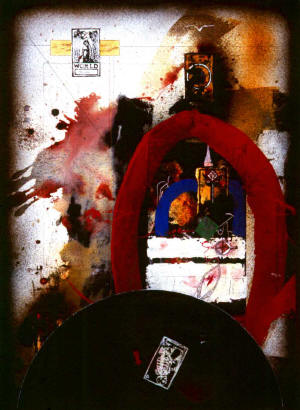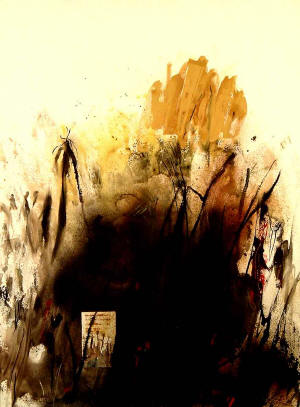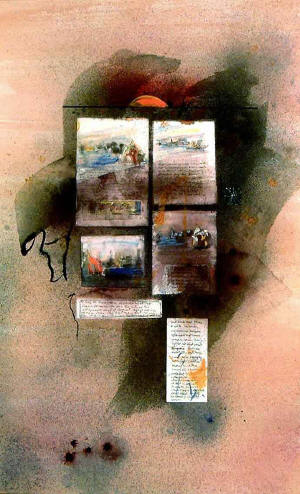Fred Martin
A Retrospective, 1948-2003
Catalog illustrations with commentaries...
Catalog nos.
65-77
Click for
Catalog
nos. 1-26.
Catalog
nos. 30-54
Catalog
nos. 55-63
Catalog
nos. 78-115
Catalog
nos. 119-137

|
Cat. no. 65. The Life of Grass I, The Scythe.
July 28, 1982.
Watercolor on paper, 40 x 40 in.
When
I began to prepare for this retrospective exhibition, I thought about
the phrase “source and goal.” The source of this painting in the
world of work is told on p### of the essay Why I Paint and What My
Work is About. And the goal—to give an easy aesthetic frisson—is
also told there. But the source of this painting in the timeless
mountains, the bead from the necklace broken in eternity? Jean was
the California poppy and I was the sheaves of the grain of Beulah
Land. I did not know but the painting foretold the
mountain—death—that lay ahead. Yes, the necklace was broken and I had
found this stone. I did not know what it was.
|

|
Cat. no. 67. Untitled. July 24-September
9, 1983.
Watercolor with collage, 40 x 30 in.
I had learned in the
1970s from the astrologer Dane Rudhyar that fate is what you are given
but destiny is what you make of it. Soon after my July 1982 painting
of the scythe in the grass, I learned the mountain ahead was death and
the bead I had found from eternity’s necklace was the same. I vowed
to use my art as a tool to fight a fate and make a destiny. In this
image, Jean as the World card of the Tarot floats in a golden heaven
while I fight death with my sword in the bloody womb of the world. I
made death fall down in art, but in life death won. Perhaps I already
knew. After all, in the art, I had put Jean in heaven. Never trust
what art might tell you. It might be what you don’t want to know.
|

|
Cat. no. 69. “We were shadows…” October
12, 1985.
Watercolor with collage on paper, 48 x 35 ½ in.
I made paintings to
tell our story; I wanted it never to be lost. I remembered a pastel I
had made in 1951 when first I began to use soft pastels. It was based
on an image from Rachmaninoff—the adagio of his Second Symphony—the
liner notes had said the whole symphony was in the mode of a psalm
that said human life is like grass. My pastel was all just the golden
grass of California with Jean’s and my shadows holding hands across
it. And then the grass had returned to my work in that fatal “cheap
frisson” of July 1982 (cat. no. 65 ). And so I made the grass
here again to tell what I now knew to be our story… “We were shadows
in the grass and like shadows were soon gone.”
|

|
Cat. no. 73. “It was in those years of
childhood.” December 30, 1985.
Watercolor with collage, 39 x 24 ½
in.
When
I was a child in Alameda, our living room had pictures of Venice in
the sunset and an Italian garden with a fountain. My room had a
Spanish galleon with a great red cross on the sail, a Viking ship with
a dragon prow, and a clipper ship all blue water and golden clouds. I
was a “ships” kid, I suppose because my parents had given me Gordon
Grant’s Book of Old Ships to look at and draw from when I was
in bed for three months with rheumatic fever. The kid across the
street was a “trains” kid (his dad worked for the Southern Pacific
Railroad). The kid across the street was older than me, and we argued
as to whether ships or trains were best. He yelled louder and I
cried. I had those pictures of Italy and of the ships all the time
until I became a student at Berkeley and was told such things were
“not art.” I made this painting to remember them forever.
|
 |
Cat. no. 77. Ashes with Poppy. December
30-January 1, 1992.
Watercolor with collage, 18 x 24 in.
In
the late 1980s, the computer became a practical tool for individual
use, and I decided to use it to make an art I could both keep and give
away. I wanted to keep my work because I thought each piece was a
stone in the arch of my life—lose a stone and the arch falls. But I
also wanted to share the work by giving it away. By making a
computer-reproducible art, I could both keep and give. I made many
pieces this way, combining computer printouts of text and simple
pictures (my printer was dot matrix and my scanner four inches wide
and hand-held) with painting. Each copy was the same image and text,
and each was painted differently. I mined my old paintings and
memories for content, slowly using all the scraps of thirty years
until nothing was left. This folder of Beulah’s last poppy in the
ashes of death was the end.
|
|
|
|
Click for
Catalog
nos. 1-26.
Catalog
nos. 30-54
Catalog
nos. 55-63
Catalog
nos. 65-77
Catalog
nos. 78-115
Catalog
nos. 119-137
|